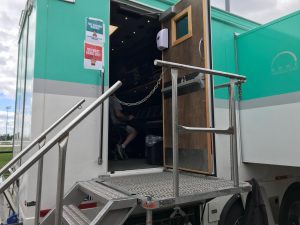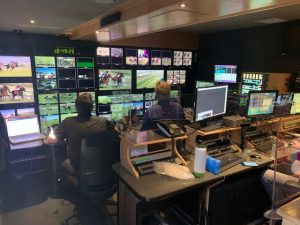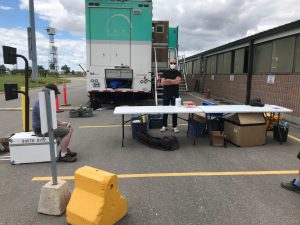TSN, Dome Productions, Woodbine Prove Set-Shoot-Strike Shows Can Be Pulled Off
‘Bubbles’ enable social distancing. Fan-less stands allow drone coverage
Story Highlights
Dome Productions rolled out its Pioneer 4K production unit yesterday at Woodbine Racetrack in Toronto for Racing Night Live, a weekly dose of live horse racing that will be shown on TSN every Thursday for the rest of the summer.
“Technically, it was great,” says Mary Ellen Carlyle, SVP/GM, Dome Productions. “Being typical Canadians, everyone respected the rules, and the staggered crew calls went really well.”
According to Paul Graham, VP/executive producer, TSN, the production made use of 12 cameras plus a drone.

Extra precautions like chains on doors helped prevent crew members from accidentally entering a truck they shouldn’t enter.
“We stole a page out of NASCAR coverage, which has incorporated a drone,” he says. “In a regular situation, we would keep the drone off the track and limit it to backside coverage and color for the lead-up to the racing.”
Adds Carlyle, “The drone was spectacular, but it isn’t something we would be able to do if fans were in the stands.”
Coverage begins at Woodbine with thoroughbred racing for an hour or so before switching over to the Mohawk racetrack located about 30 minutes away.
Six people work out of the Pioneer production unit, but the executive producer has been moved from the main truck to the EVS unit, where there was a little more room for social distancing. The team totaled 23. Pioneer is also outfitted with MERV13 air filters and a HEPA filter in the truck to clean the air.

A look inside Dome Production’s Pioneer unit which will be use for horse racing coverage at Woodbine.
The host position is located outside, and commentators are about 10 ft. apart. Trackside, the reporter has a mic on a stick to increase distancing. At Mohawk, track calls are used along with the trackside reporter.
The production team works in four “bubbles,” and everyone self-declares rather than going through COVID-19 testing, according to Lori Macdonald, senior production manager, Dome Productions,
“At the venue, there will be a temperature check, and everyone will fill out a form at the venue,” she explains. “As for the bubbles, there are two inside the track and then the truck and then a transition area. But we have been working with the venue, [where] there is lots of room given that we are outside and there are no fans.”
Carlyle notes that the transition area is a table with an engineer on either side. Equipment can be moved between bubbles at that table, and the crew picks up headsets and go-bags there.
Each bubble has dedicated meal and washroom facilities.
Graham says that the safety protocols would look different for an arena or stadium and that the bubbles approach is effective because it keeps people safely separated. Macdonald points out that third-party installations were done ahead of time so that the production could be more “plug-and-play.”
The plan is to cover races through the summer, with the Canadian triple crown, highlighted by the Queen’s Plate race, moved to the fall. Graham and Macdonald expect to develop new approaches to safety on a weekly basis, not only from their own experiences but from what is going on in the broader industry.
“We did a couple of things that have been useful, including a Zoom call with the crew the day before,” says Macdonald. “We also have a couple of videos on how to work safely in this environment.”
Another step the team takes is to sanitize all the headsets.
“You need to communicate as much information as possible and get documentation to the folks as well,” says Macdonald. “We also want to get feedback, suggestions, and ideas from the crew to make it safer and better. We’re all ears for feedback and opinion.”
Like the NASCAR races and the PGA events, the Woodbine facility provides plenty of room for everyone to maintain social distancing. But Carlyle says a B unit may be added to the mix just to provide additional space.
“The big thing for a set-shoot-strike was the planning that made it almost plug-and-play, the Zoom calls with freelancers and the client,” adds Carlyle. “And, with respect to strike, you definitely need a couple of extra people at the truck if the venue people can’t help out at the truck.”

